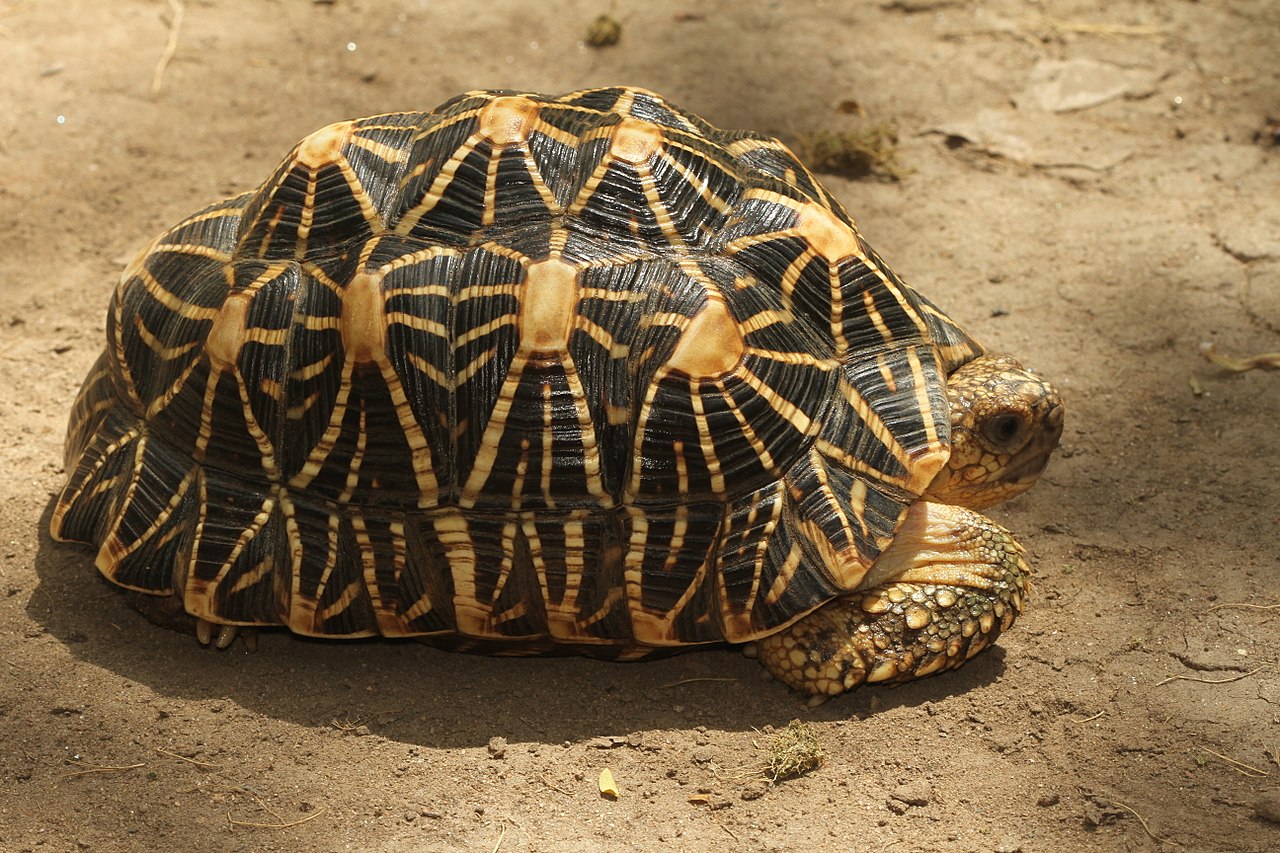
An Indian star tortoise, June 2016. Photo: Davidvraju/Wikimedia Commons, CC BY-SA 4.0.
Slow, sturdy and steadily vanishing – this description has become tragically apt for the Indian star tortoise (Geochelone elegans). These reptiles’ natural range encompasses India, Pakistan and Sri Lanka.
Their characteristically ornate carapace, an adaptation for camouflage and survival in arid deciduous habitats, has made star tortoises popular as pets – and they have thus become the world’s most-traded tortoise. As a result, they have gone from being touted the most common testudines in India to a species whose natural range is now restricted to northwestern and southern India, with small-pockets in central India.
Indian star tortoises account for almost half of all chelonian (turtle and tortoise) seizures in India. In fact, globally dispersed seizures indicate the presence of a coordinated wildlife-crime enterprise at the market’s heart.
Taking cognisance of the extinction threat to the species, they were recently upgraded to protections under Appendix I of the Convention on International Trade in Endangered Species of Wild Fauna and Flora (CITES). At the same time, efforts to conserve the species have been held back by lack of data on the species’ baseline population – as well as few and far between themselves.
India is home to the Indian star tortoise’s largest wild population and also has the most extensive range. India’s Wildlife (Protection) Act 1972 – the primary legal instrument protecting indigenous species through graded Schedules – has been both historically and contemporarily negligent towards tortoises.
The 29 chelonian species in India face challenges on multiple fronts, including universal threats like habitat degradation and climate change. But there is a big discrepancy between protection and conservation benefits accorded to turtles and tortoises.
According to a TRAFFIC report published in 2019, the Indian star tortoise, the Indian flapshell (Lissemys punctata), the Indian softshell (Nilssonia gangetica) and the black pond turtle (Geoclemys hamiltonii) are India’s most traded chelonians. However, only the last three have been placed in Schedule I – the highest level of protection – of the Act, affording them appropriate conservation interest and stronger protections through stricter punishments. The even more trafficked Indian star tortoise however languishes in Schedule IV, the lowest level of protection available in the Act for threatened animals.
Being listed in Schedule IV also perpetuates public ignorance and indifference towards the crisis caused by the pet trade. The protection to a Schedule IV species is insignificant in terms of both financial penalty and risk of imprisonment. The laxity therefore encourages trade of Indian star tortoises to continue. The lowly conservation status also constricts research focus and attention the species receives.
So however visionary in constitution and its mandate the Wildlife (Protection) Act may have been, it remains ineffectual at saving one of the country’s most trafficked tortoises. In fact, the Indian star tortoise’s status wasn’t promoted from Schedule IV even after the species was added to CITES’s Appendix I. Note that both India and Sri Lanka are parties to CITES and had supported the upgrade bid.
Also read: Despite Arrests, Illegal Trade in Star Tortoises Continues Unabated
The Indian government has thus batted for higher protection for the Indian star tortoise on an international platform but complementary local efforts are yet to materialise. while CITES is an international forum that has a significant influence on transnational wildlife trade, it can’t compensate for inadequate regional efforts. And inconsistent national and international policies can only impede on-ground conservation efforts.
The people at the two ends of the wildlife pet market – poachers and pet keepers – are both largely ignorant of the implications of the trade on wild populations; this has been the headache of conservationists and naturalists alone for many years. So without a dedicated national action plan to track wildlife trade, along with devoted sensitisation drives, the situation is only bound to become more grim.
In captivity, Indian star tortoises are prone to carapacial abnormalities and decreased lifespan. There are also no records of large-scale captive breeding, implying that the bulk of the trade in these creatures involves wild individuals.
With profit margins increasing with the number of star tortoises, traders prefer juveniles because they are easier to pack and transport. This in turn diminishes already diminishing wild populations because the population loses individuals before they have reached sexual maturity and can contribute to the gene pool. And this then compromises the population’s genetic diversity.
In 2015, researchers reported that over 55,000 juvenile Indian star tortoises had been poached from a single location in Andhra Pradesh – orders of magnitude greater than previous estimates and potentially disastrous for small vulnerable populations.
On the flip side, more and more of Indian star tortoises are to be found in Indian zoos, which are famously resource-deficient.
Most rehabilitation efforts of the Indian star tortoise have been unscientific, and an important consequence has been the release of these reptiles into non-native habitats. There are significant morphological variations between northwestern Indian, southern Indian and Sri Lankan populations. Sweeping releases into genetically distinct populations could cause genetic disturbances and erase phylogeographic signatures.
For example, a study by researchers at the Centre for Cellular and Molecular Biology, Hyderabad, found that more than half of Indian star tortoises seized at Singapore airport in 2006 couldn’t be traced to their original sites.
Scientists at the Wildlife Institute of India are currently conducting an India-wide study to produce a comprehensive molecular database, which in turn could help track the origins of confiscated Indian star tortoises. This should be supplemented by a sensitisation and awareness exercise plus multi-sectoral collaborations to push back the pet trade. Finally, India must upgrade the Indian star tortoise’s status in the Wildlife (Protection) Act.
Subhashree Sahoo is a researcher working with Indian star tortoises. She has also been working on wildlife forensics against the wildlife trade.

